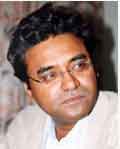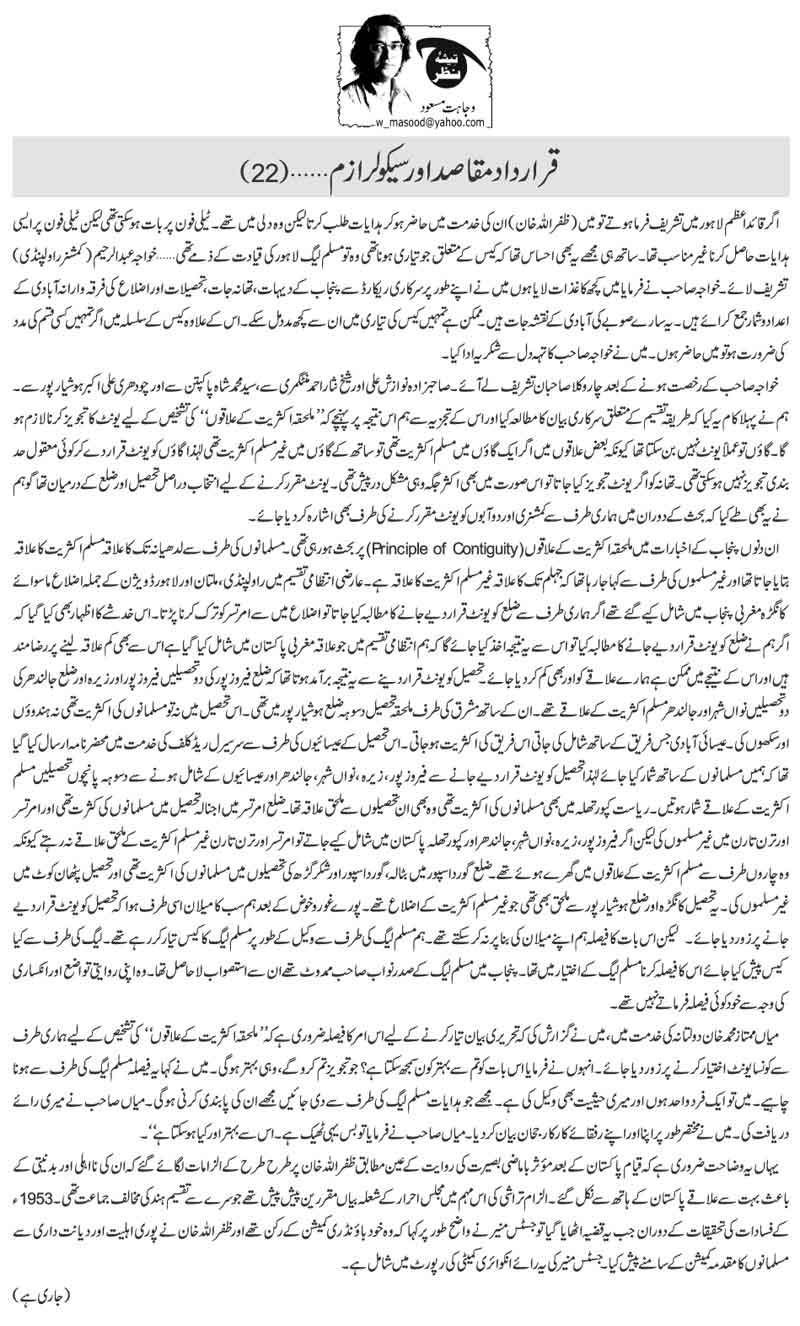
The founder of Pakistan, Mohammad Ali Jinnah, wanted a separate
country for Muslims but his political upbringing in a pluralist society
prevented him from declaring Pakistan an Islamic state. Contrary to the general
perception in India, Mr Jinnah was arguably a secular and liberal Muslim who
wanted a Pakistan where all citizens would be equal in the eyes of the
constitution irrespective of their religion, caste or creed. But leaders like
Liaqat Ali Khan and power hungry opportunistic religious leaders wanted it to be
otherwise. In this beautifully written series titled, "Objectives Resolution and
Secularism", Mr Wajahat Masood delves deep into history to find out how Jinnah's
dream of a secular and democratic Pakistan was shattered. -- Editor
----
IN the temporary administrative
division, Rawalpindi, Multan and all the districts of Lahore division except
Kangra had been included in the West Punjab. If we had demanded the districts to
be the unit, then we would have sent the message that we were willing to accept
an area smaller than what had been included in the west Pakistan in the
administrative division, and as a result the area alloted to us would have
possibly been further reduced. If the tehsils were to be made the unit, two
thesils of district Ferozpur and Zeera and two tehsils of district Jullundur,
Nawan Shahr and Jullundur emerged as Muslim majority areas. Alongwith them, the
adjoining tehsil Dasoha was in district Hoshiarpur. In this tehsil, neither the
Muslims nor the Hindus-Sikhs were in majority. The support of the Christians
would decide which community was in majority. A request was sent on behalfof the
Christians of the tehsil to Sir
Radcliffe for clubbing them
together with the Muslims. So in case of the tehsils being declared units, all
the five tehsils -- Ferozpur, Zeera, Nawan Shahr, Jullundur and, with the
support of the Christians, Dasoha would be counted among the Muslim majority
areas. Muslims were also in majority in the state of Kapurthala, which was
adjacent to these five states. In Ajnala
tehsil in district Amritsar, Muslims
were in majority while in Amritsar and Taran Taran the non-Muslims were in
majority. -- Wajahat
Masood

By Wajahat
Masood
(Translated from
Urdu by Sohail Arshad)
Had Qaid-e-Azam been
present in Lahore, I ( Zafarullah Khan) would have gone and consulted him for his instructions, but he was in
Delhi. I could have spoken over telephone but did not consider it appropriate to
seek instructions on those matters over
the phone. At the same time I also knew that the preparations to be made for the
case was the responsibility of the Lahore leadership of the Muslim League.
Khwaja Abdur Rahim (commissionr, Rawalpindi) arrived. He said, “I have brought
some papers. I have compiled religion-wise statistics of the villages, thanas,
tehsils, and districts of Punjab on my own. This is a picture of the population
of the entire province. It might possibly help you in the preparation of the
case. In addition to these, If you need any help regarding the case, I will be
available.” I thanked Mr Khwaja from the bottom of my heart.
After Mr khwaja
left, four lawyers came in. Among them Sahabzada Nawazish Ali and Sheikh Nisar
Ahmad were from Montgomery, Syed Md. Shah was from Pakpatan and Chaudhry Ali
Akbar from Hoshiarpur. The first thing we did was study the government’s
statement about the procedure of Partition. An analysis of it led us to the
conclusion that to mark out the majority contiguous areas, the formation of a
unit would be imperative .
Practically a village
could not be a unit because in certain areas if a village had the Muslims in
majority, the adjacent village was dominated by the the non-Muslims. Therefore,
by declaring a village a unit, no appropriate suggestion could be made for
drawing a boundary. If a thana was considered a unit, the same problem would
arise. To decide on a unit, the choice was, in fact, between a tehsil and a district,
though we decided to hint at commissionery and do-abahs as well for the fixation
of a unit during our debate.
During that period, a
debate was going on on the Principle of Contiguity in the newspapers of the
Punjab. The Muslims would argue that the areas till Ludhiana were dominated
by them while the non-Muslims would
insist they were in majority in areas till Jhellum.
In the temporary
administrative division, Rawalpindi, Multan and all the districts of Lahore
division except Kangra had been included in the West Punjab. If we had demanded
the districts to be the unit, then we would have sent the message that we were
willing to accept an area smaller than what had been included in the west
Pakistan in the administrative division, and as a result the area alloted to us would
possibly be further reduced. If the tehsils were to be made the unit, two
thesils of district Ferozpur and Zeera and two tehsils of district Jullundur,
Nawan Shahr and Jullundur emerged as Muslim majority areas. Alongwith them, the
adjoining tehsil Dasoha was in district Hoshiarpur. In this tehsil, neither the
Muslim nor the Hindus-Sikhs were in Majority. The support of the Christians
would decide which community was in majority. A request was sent on behalfof the
Christians of the tehsil to Sir
Radcliffe for clubbing them
together with the Muslims. So in case of the tehsils being declared units, alll
the five tehsils -- Ferozpur, Zeera, Nawan Shahr, Jullundur and, with the
support of the Christians, Dasoha would be counted among the Muslim majority
areas. Muslims were also in majority in the state of Kapurthala, which was
adjacent to these five states. In Ajnala
tehsil in district Amritsar, the Muslims
were in majority while in Amritsar and Taran Taran the non-Muslims were in
majority.
However, if Ferozpur,
Zeera, Nawan Shahr, Jullandur and Kapurthala were included in Pakistan, then
Amritsar and Taran Taran would cease to be non-Muslim contiguous areas because
they were surrounded on all the four sides by Muslim-majority
areas.
In district Gurdaspur,
the tehsils of Batala, Gurdaspur and Shakargarh, the Muslim were in majority and
the tehsil of Pathankot was dominated by non-Muslim population. This tehsil was
adjacent to Kangrah and distict Hoshiarpur which were non-Muslim majority
districts. After hectic delibarations, we came to the conclusion that we should
stress on the tehsils to be declared the unit. But we were not supposed to
decide on it merely on our own conclusion.We were only building up a case in
favour of the Muslim league as its lawyers.
The Muslim league had the
sole authority to decide how they wanted to put up their case. The President of
the Muslim League of Punjab was Nawab of Mumdoot but seeking his opinion was
useless because out of his sophistication and humility he did not make his own
decision on any issue.
I told Mian Mumtaz
Ahmed Khan Daultana that it was
important to decide which unit to recommend for marking out the majority contiguous areas.
He said, “ Who can understand this better than you? Whatever you propose will be
appropriate.” I said, “The decision should be made by the Muslim League. I am an
individual and I am in the capacity of a lawyer. I will have to abide by the
instructions issued by it.” Mr. Khan asked for my opinion. I informed him of the
opinion of our lawyer colleagues in
brief. Mr. Khan said, “ Then it’s all right. Nothing can be better than
that.”
It should be clarified at
this point that after the establishment of Paksitan, the detractors of
Zafarullah Khan alleged that because of his incompetence and insincerity many
areas went out of Pakistan. The firebrand speakers of Majlis-e-Ahrar, the
organisation which opposed the partition of India vehemently, were in the forefront of this villification
compaign. When the issue was raised during the inquiry of the riots (against the
Ahmadis) in 1953, Justice Munir categorically said that he himself was a member
of the Boundary Commission and Zafarullah Khan had presented the case of the
Muslims before the Commission according to his best abilities and sincereity.
Justice Munir’s statement is included in the inquiry report.





 Sultan Shahin
Sultan Shahin


0 comments:
Post a Comment